The N.W. & B.I.T. Co
by Mark Lauckner
Reprinted from "Crown Jewels of the Wire", November 1994, page 9
The New Westminster and Burrard Inlet Telephone Company, and the rapid spread
of telephone use in western Canada during the 1880's was, of course, sparked by
Robert Burns McMicking. McMicking was an "overlander", accompanying
his brother when drawn from the east by the great Cariboo gold rush in northern
BC in 1862.
After the gold rush, he was employed by the Collins' Overland
Telegraph project, and then became the superintendent of the Western Union
Telegraph Co. The head office was at Yale, and he would have overseen the
building of the second line into northern BC, (the one with the upside down
EC&M's and cobalt Cal's on it).
He was fired from Western Union when he was
discovered to have been spending company funds on telephone sets for use on
lines he was constructing in the Victoria and Vancouver area.
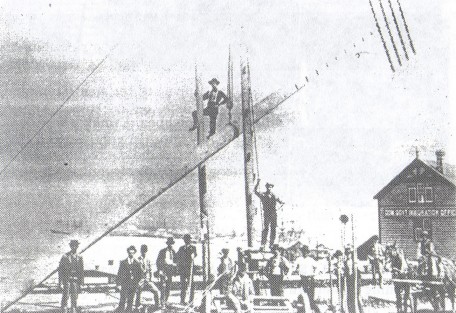
N. W. & B.I.T. line crew raising a pole in downtown Vancouver c. 1900
Two Port Moody
real estate speculators, William Weeks and Charles Foster, were impressed by his
two successful lines in the Vancouver area and formed a telephone company there
in 1883. With a loan from J. C. "Cariboo Joe" Armstrong, construction of their
first line was completed in November of that year between New Westminster
(also known as the Royal City) and Port Moody, the western terminus of the (yet
to be completed) Canadian Pacific Railway. In February 1884 they incorporated and
became the New Westminster and Port Moody Telephone Co. One year later,
Armstrong took over the company for $26.00 owing on a barrel of glass
insulators. These would not have been N.W. & B.I.T. embossed pieces, as the
company name had not been changed until after that time.
The CPR decided to move
the location of its western terminus further down the inlet to the coast. Port
Moody real estate values collapsed. The NW & PM Tel. Co. quickly fell into
the hands of creditors.
The creditors, Joseph Armstrong and the Bank of BC,
expanded the service to Granville (now Vancouver), and on April 8, 1886, finally
incorporated under the name New Westminster & Burrard Inlet Telephone Co.
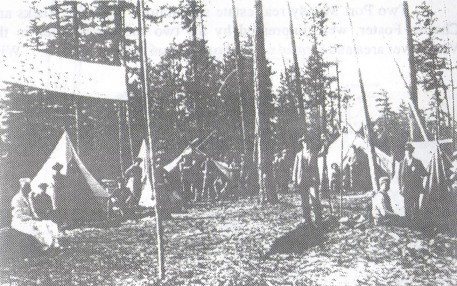
Vernon & Nelson line crew
On April 20, 1891, the N.W.& B.I.T. Co. expanded its operation to the mining
boomtown of Nelson, in the southern interior of British Columbia, and formed a
subsidiary, the Vernon & Nelson Telephone Co. (Several N.W.& B.I.T.Co
insulators have been located in this area over the years.)
In 1898 the N.W.& B.I.T. Co. was sold to Yorkshire Securities, of Britain,
which also absorbed several other small telephone companies in British Columbia
around the same time. These included McMicking' s Victoria & Esquimalt Tel.
Co., Naniamo, Slocan, Boundary & Kootenay Lakes, thus forming a monopoly.
In 1902 the N.W. & B.I.T. Co.'s charter was expiring, so all the interests
were consolidated into the V.& N. Tel. Co, whose charter was renewable.
Yorkshire Securities changed the name to the British Columbia Telephone Company,
and was sold to American interests, and remains that way today.
The insulators
used on the original line from New Westminster to Port Moody were the U-48 Fred
M. Locke mottled tan porcelain.
The scarce and beautiful CD102 N.W. & B.I.T.
Co. insulators, however are more obscure. The two curious aspects of these
wonders are: who is responsible for their manufacture, and, what was under the
blot-outs on the type 2 and type 3 molds?
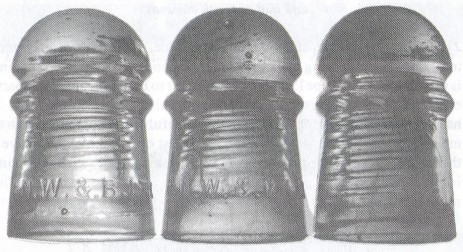
N. W. & B.I.T. Co. Mold styles: Type 1, Type 2, and Type 3
There were three molds known to be used for the production of these
insulators. All are three piece molds, with very thin lower skirts and a round
base.

Style 1, tall ampersand ( & )
1) The first mold has a tall ampersand and wide period spacing, and no
blot-out or very very faint blot-out on the back. This style seems to be the
most scarce of the three. The colors are It. green and off-clear ... grey. Three
of the six light green ones known (to me) have a portion of the dome ground
down, as a result of being screwed onto wooden chair legs. (Around the turn of
the century it was assumed that this practice was helpful in reducing electric
shocks to telephone switchboard operators.)

Style 2, short and wide ampersand ( & )
and blot out with commas
2) This style is the most available of the three, although still very hard to
find. The embossing has a shorter ampersand, and the period spacing is different
than in Type 1. There also appears to be a blot-out under parts of the
lettering. The blot-out and the comma also appear on the back. It has been found
in a color range from a beautiful crystal-clear through to medium SCA, and in
grey, and smoke. Most of this mold style have a thin line of milk running up one
side of the threads and swirling around in the dome. The low pin hole, full
round top, and transparent quality make these insulators glow and reflect light
in the solid glass like a lens.

Style 3 with blot out on front (with comma, as seen on
the rear of Style 2)
and a blot out on the rear
skirt with a period at the end.
3) The third style is unmarked, but does have blot-outs on each side. One
side has the same blot-out as found on type 2, with the comma, and the other side has a blot-out with a period at the end. This would not have
been the N.W. & B.I.T.Co lettering, because both embossed styles have no
period at the end. The colors known are light green and clear. These are also
hard to find, and are easily mistaken for the more common CD 102 NN Canadian
MLOD, or NN Canadian (Diamond blot out) insulators. (Check them closely for the
very thin skirts and the blot-outs).
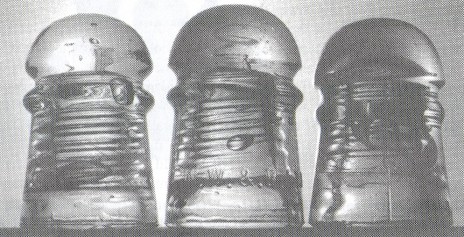
Three Canadian Ponies: NN MLOD, NW & B.I.T. Co, NN Bar Diamond
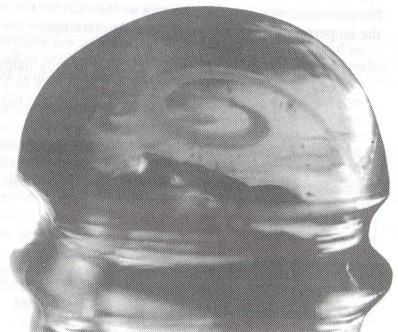
Dome milk swirls found in most N.W.& B.I.T. Co. insulators.
It has been assumed by collectors that the Crystal Glass Co. of the Burrard
Inlet area was responsible for the manufacture of these insulators. However the
N.W. & B.I.T. Co. name had been changed to B.C. Tel. five years before the
glass factory was built. The quality of glass is also different from that of the
CD113 Braille and the CD164 Petticoat, also assumed to be made at Crystal Glass.
The mold is unique. There is no other CD102 mold that I am aware of that has the
same low pin hole and very thin lower skirt.
The quality of the glass does
suggest that insulator production was a sideline for whoever made them. The
color range of clear to SCA suggests the use of manganese to remove the green
tint of iron oxide impurities in the glass. The milk streaks found in most of
these insulators would not have been acceptable glass for windows or tableware
(of which pressed glass of that quality was usually used). If you were a window
manufacturer and had a run of manganese-cleared glass contaminated with a milky
streak what would you do with it? Perhaps you would press some insulators until
the milk streak was no longer visible.
Another puzzling aspect of this insulator
are the blot-outs. There were name changes and subsidiaries within the company,
but none can be easily abbreviated to have a comma placed after the first three
letter spaces. I think it would be safe to assume that a comma was used because
there was not enough room on the skirt for the added width of the ampersand.
Here are some possible markings:
N.W.,P.M. Tel. Co. (the Port Moody name)
Vic., Esq. Tel. Co. (McMicking's
company in Victoria)
Vrn., Nelson Tel. Co. (the 1891 subsidiary)
The blot out on the other side of Type 3, with the period at the end, is also
curious, and could have been one of the above. Perhaps in the years to come more
information and specimens will surface.

N.W. & B.I.T. letterhead provided by Robin Harrison of Seattle,
Washington
| 